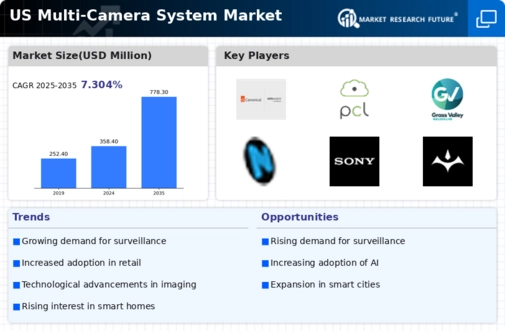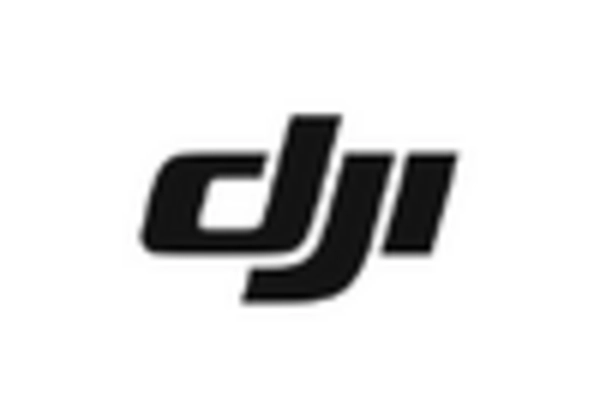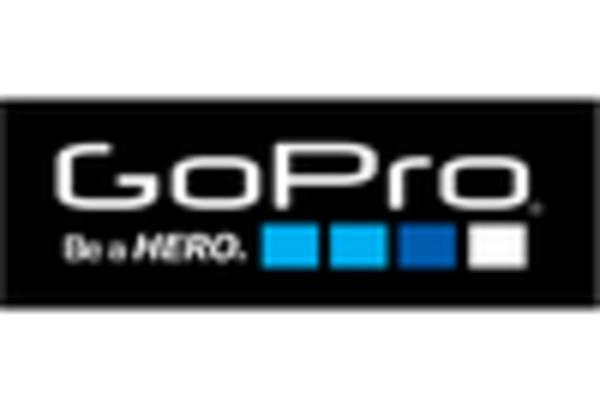Increased Regulatory Compliance
Increased regulatory compliance requirements are shaping the multi-camera system market. Various industries, including finance, healthcare, and transportation, are subject to stringent regulations regarding data security and surveillance. Compliance with these regulations often necessitates the implementation of advanced monitoring systems, driving demand for multi camera solutions. For instance, the financial sector is expected to invest over $5 billion in compliance-related technologies by 2027, which includes surveillance systems. This trend suggests that organizations are prioritizing investments in multi camera systems to ensure adherence to legal standards while enhancing their security posture. As regulatory frameworks evolve, the multi camera-system market is likely to see sustained growth as businesses seek to mitigate risks associated with non-compliance.
Expansion of Smart Infrastructure
The expansion of smart infrastructure is a key driver for the multi-camera system market. As cities and municipalities invest in smart technologies to enhance urban living, the integration of multi camera systems becomes essential for effective monitoring and management. These systems facilitate real-time data collection and analysis, which is crucial for traffic management, public safety, and environmental monitoring. The smart city initiative is projected to grow at a CAGR of 20% over the next decade, indicating a substantial opportunity for the multi camera-system market. This growth is likely to encourage partnerships between technology providers and urban planners, fostering innovation and the development of tailored solutions that meet the specific needs of smart cities.
Rising Consumer Awareness and Demand
Rising consumer awareness regarding safety and security is a significant driver for the multi-camera system market. As individuals become more informed about the benefits of surveillance systems, there is a growing demand for residential and commercial security solutions. This trend is reflected in the increasing sales of home security cameras, which have seen a growth rate of 25% annually. Consumers are now more inclined to invest in multi camera systems that offer features such as remote monitoring, cloud storage, and integration with smart home devices. This heightened awareness is likely to propel the market forward, as manufacturers respond by developing user-friendly and feature-rich products that cater to the evolving needs of consumers.
Technological Advancements in Imaging
The multi-camera system market is experiencing a surge due to rapid technological advancements in imaging technologies. Innovations such as high-definition (HD) and 4K resolution cameras are becoming increasingly prevalent, enhancing the quality of surveillance and monitoring systems. The integration of advanced sensors and optics is also contributing to improved image clarity and detail. According to recent data, the market for HD cameras is projected to grow at a CAGR of 15% over the next five years. This growth is indicative of the increasing demand for high-quality imaging solutions in various sectors, including retail, transportation, and public safety. As these technologies continue to evolve, they are likely to drive further investment in multi camera-system market solutions, enabling more sophisticated applications and functionalities.
Growing Demand for Surveillance Solutions
The multi-camera system market is significantly influenced by the growing demand for surveillance solutions across various sectors. With increasing concerns regarding safety and security, businesses and government entities are investing heavily in surveillance systems to monitor activities and deter criminal behavior. The market for surveillance cameras is expected to reach $10 billion by 2026, reflecting a robust growth trajectory. This demand is not only driven by traditional security needs but also by the need for operational efficiency and analytics in sectors such as retail and logistics. As organizations seek to leverage video data for insights, the multi camera-system market is poised to benefit from this trend, leading to enhanced product offerings and increased market penetration.

















Leave a Comment